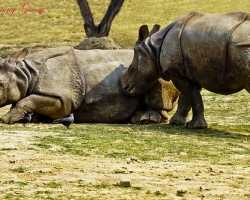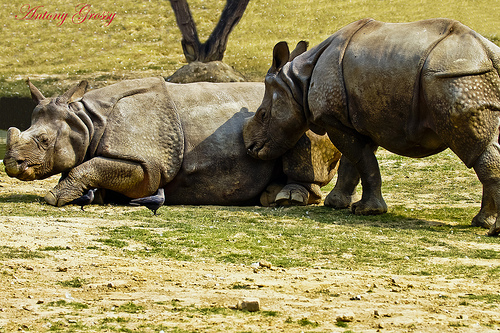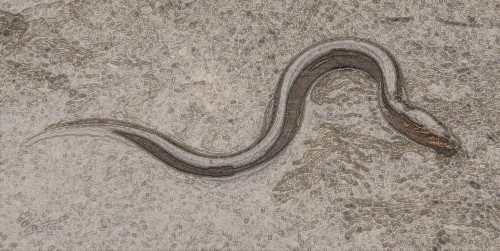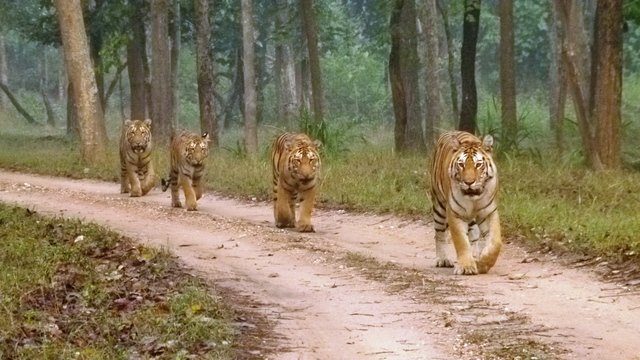RESEARCH: For a species to survive well in the planet the existing members should live safely in a healthy environment and the birth of future generations should continue at a regular pace. But the Indian rhinoceros (Rhinoceros unicornis) is not surviving too well in the existing world. Not only is the animal getting lesser and lesser habitat to live in, but the real threat to its existence has been the rampant poaching leading to more rhino deaths than ever before. Now adding to the woes of conservationists, scientists from Germany have found that the birth of future generations of this particular animal faces a peculiar challenge that is pushing the species all the more towards extinction – high risk of infertility.
Researchers from the German Leibniz Institute for Zoo and Wildlife Research Berlin (IZW) together with American colleagues found that Indian rhinos have high rate of benign vaginal and cervical tumours causing infertility even in young females. So while poachers are killing the present animals, the chance of more number of baby rhinos coming into the world is at risk too because of fertility problems. This potential infertility risk may not just reduce the number of offspring born in the wild, but also babies born through captive breeding.
Understanding Rhino Births
Female Indian rhinos become sexually mature at about the age of three and can live up to 40 years of age. Theoretically they can give birth till the end of their lives, but in zoos or captivity they give birth until the age of 18 years. This is revealed by records in the international studbook for Indian rhinoceros which registers the life histories and reproductive success of all 189 Indian rhinos living in zoos worldwide.
Additionally the researchers found, that if the rhinos gave birth for the first time at the age of five, they had up to 6 babies in their lives. But if the rhino mom was older than five years when it gave birth to its first baby, the female rarely became a mom for more than two times.
To understand the female rhino reproductive system better, the researchers Robert Hermes, Frank Göritz und Thomas Hildebrandt, all veterinarian scientists at the IZW, and their colleague Monica Stoops from Cincinnati Zoo analysed ultrasound data of 23 female Indian rhinos. This study was carried out several times in the span of 20 years.
They found that already at the age of 13 all the female rhinos had developed tumors in their reproductive organs!
The researchers write,
“Already at the age of 13 years all animals had developed tumours! The tumours grow rapidly, uncontrolled and lifelong until the vagina and cervix are completely covered in them.”
“Besides the pain which the female must be experiencing because of the tumour, the mating act becomes almost impossible and even if successful, there is no free passage available to the sperm anymore,” explains Robert Hermes.
Humans and Rhinos
In order to compare this particular condition in female rhinos, the researchers then looked for another species with a similar condition and were surprised to find humans, having similar tumors. Most women close to their menopause developed such benign tumors.
“Eighty per cent of all women have such leiomyomas at the onset of their menopause. Leiomyomas can already start to develop in adolescence and they grow as a function of ovarian activity. In contrast to the rhinos the mostly benign tumours in women are located in the uterus and remain without symptoms,” says Hermes.
Because of the hormonal changes experienced by women during pregnancy or lactation, the tumors do not grow further or show any symptoms during these periods. Also if the women have given birth to at least one child the chance of them developing such tumors is reduced by 40 percent.
Using the same analogy, the scientists deduced that in rhinos too if the female gave birth for the first time at a younger age, the chances of tumor growth reduced and they thus gave birth to more number of offspring in their lives. If on the other hand the first pregnancy was later, the tumors had already begun to develop and the rhino females were unable to have more offspring.
Ensuring Conservation
The important inference of this research is that whether the rhino births are in the wild or in zoos, if the female rhinos become pregnant at least by the age of five, the chances of them giving birth to more number of offspring increases, ensuring a good rise in population of the species.
Indian rhinos are an endangered species with many of the adult rhinos being killed almost every day for their horns that are used for traditional medicines in South east Asia. Only 2,900 animals remain in the wild. Under such circumstances it is imperative that the birth of young ones at a constant pace ensures species preservation.
While in the wild, the birthing may not be controlled, but for captive breeding the authors strongly recommend to start breeding at an early stage and to optimise breeding conditions to maximise the chance of females becoming pregnant.
Most zoos hesitate too long until the conditions for natural mating are created — sometimes 12 or 13 years, deplores Hermes.
“This is too late, since all female Indian rhinos do already have tumours in this stage of life. More than one calf is then unlikely.”
“We should not rely on higher rates of reproduction in free-living Indian rhinos than those in captivity,” says Robert Hermes. “Zoological gardens are responsible for a coordinated breeding programme which uses the genetic diversity of the entire population. It would be disastrous, if only because of early tumour diseases breeding is confined to only a few animals who may produce a high number of offspring and the majority bear fewer or no calves.”
More Related Stories,
Another Rhino Death in India Scars World Rhino Day
Defense Ministry Says No to Use of Drones in Kaziranga
Hand Reared Rhino Creates History: Gives Birth in the wild
Image via cc/Flickr by Steve Wilson, Rajkumar 1220, Antony Grossy









One thought on “High Infertility Rates Putting Indian Rhinos at Greater Risk of Extinction”